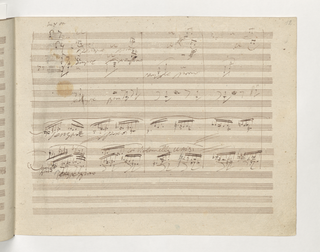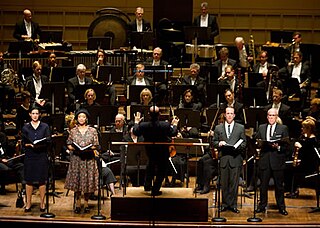Related Research Articles

The Symphony No. 9 in D minor, Op. 125, is a choral symphony, the final complete symphony by Ludwig van Beethoven, composed between 1822 and 1824. It was first performed in Vienna on 7 May 1824. The symphony is regarded by many critics and musicologists as Beethoven's greatest work and one of the supreme achievements in the history of music. One of the best-known works in common practice music, it stands as one of the most frequently performed symphonies in the world.

The Dallas Symphony Orchestra (DSO) is an American orchestra based in Dallas, Texas. Its principal performing venue is the Morton H. Meyerson Symphony Center in the Arts District of downtown Dallas.

The Symphony No. 4 in B♭ major, Op. 60, is the fourth-published symphony by Ludwig van Beethoven. It was composed in 1806 and premiered in March 1807 at a private concert in Vienna at the town house of Prince Lobkowitz. The first public performance was at the Burgtheater in Vienna in April 1808.
Christopher Chapman Rouse III was an American composer. Though he wrote for various ensembles, Rouse is primarily known for his orchestral compositions, including a Requiem, a dozen concertos, and six symphonies. His work received numerous accolades, including the Kennedy Center Friedheim Award, the Grammy Award for Best Classical Contemporary Composition, and the Pulitzer Prize for Music. He also served as the composer-in-residence for the New York Philharmonic from 2012 to 2015.

Jaap van Zweden is a Dutch conductor and violinist. He is currently music director of the Hong Kong Philharmonic Orchestra and of the New York Philharmonic.

Conrad Yiwen Tao is an American composer and pianist and former violinist. Tao's piano and violin performances since childhood brought him early recognition at music festivals and competitions, and he is receiving critical praise for his recitals and concerts with symphony orchestras. At age 13, he was featured on the PBS TV series From the Top – Live from Carnegie Hall as violinist, pianist and composer. He won eight consecutive ASCAP Morton Gould Young Composer Awards. Among his compositions have been commissions by the New York Philharmonic, Hong Kong Philharmonic, Pacific Symphony and Dallas Symphony Orchestra.

The Symphony No. 5 in C minor of Ludwig van Beethoven, Op. 67, was written between 1804 and 1808. It is one of the best-known compositions in classical music and one of the most frequently played symphonies, and it is widely considered one of the cornerstones of western music. First performed in Vienna's Theater an der Wien in 1808, the work achieved its prodigious reputation soon afterward. E. T. A. Hoffmann described the symphony as "one of the most important works of the time". As is typical of symphonies during the transition between the Classical and Romantic eras, Beethoven's Fifth Symphony is in four movements.
Christopher Martin is an American trumpet player who was named the principal trumpet of the New York Philharmonic in May 2016 and began his tenure there in September 2016. He has also served as Principal trumpet of the Chicago Symphony Orchestra (2005-2017) and the Atlanta Symphony Orchestra (2000-2005), and as Associate Principal of the Philadelphia Orchestra (1997-2000). He has also performed with High Bridge Brass, an American conical brass quintet, since its founding in June 2018. During his time in Chicago, Martin gave the world premieres of several trumpet concerti, notably Christopher Rouse's Heimdall's Trumpet in 2012.
Symphony No. 3 is an orchestral composition in two movements by the American composer Christopher Rouse. The work was jointly commissioned by the St. Louis Symphony, the Baltimore Symphony Orchestra, the Royal Stockholm Philharmonic Orchestra, and the Singapore Symphony Orchestra. It was completed February 3, 2011 and premiered May 5, 2011 by the Saint Louis Symphony under David Robertson at Powell Hall in St. Louis, Missouri. The piece is dedicated to Rouse's high school music teacher, John Merrill.

August 4, 1964 is an oratorio for mezzo-soprano, soprano, tenor, baritone, choir, and orchestra written by the American composer Steven Stucky with a libretto by Gene Scheer. It was commissioned by the Dallas Symphony Orchestra in honor of the centennial of the birth of 36th U.S. President Lyndon B. Johnson. The piece premiered September 18, 2008 at the Morton H. Meyerson Symphony Center in Dallas, with conductor Jaap van Zweden leading mezzo-soprano Kelley O'Connor, soprano Laquita Mitchell, baritone Robert Orth, tenor Vale Rideout, the Dallas Symphony Chorus, and the Dallas Symphony Orchestra. The work specifically follows the events of August 4, 1964 during Johnson's presidency, including the Gulf of Tonkin incident and the discovered bodies of three murdered civil rights workers in Neshoba County, Mississippi.
Rhapsodies for Orchestra is a single-movement orchestral composition by the American composer Steven Stucky. The work was jointly commissioned by the New York Philharmonic and the BBC for the Philharmonic's European tour in August and September 2008. The piece had its world premiere August 28, 2008 in Royal Albert Hall at The Proms, with the New York Philharmonic performing under conductor Lorin Maazel.
John Borstlap is a Dutch composer and author on cultural subjects related to music and the visual arts. His work is rooted in German musical traditions and he is a proponent of a revival of tonal and classical traditions.
The String Quartet No. 2 is the second string quartet by the American composer Christopher Rouse. The work was commissioned by the Cleveland Quartet with additional contributions from the Eastman School of Music and was completed May 6, 1988. It was given its world premiere at the Aspen Music Festival by the Cleveland Quartet in July 1988. Rouse dedicated the composition to the people of the Soviet Union.
Karolju is a suite of original Christmas carols for choir and orchestra by the American composer Christopher Rouse. The work was commissioned in 1989 by the Baltimore Symphony Orchestra with support from the philanthropist Randolph Rothschild and the Barlow Endowment. It was completed in November 1990 and first performed on November 7, 1991 by the Baltimore Symphony Orchestra and Chorus conducted by David Zinman. The piece is dedicated to Rouse's daughter Alexandra.
Berceuse Infinie is an orchestral composition by the American composer Christopher Rouse. The work was commissioned by the Baltimore Symphony Orchestra and was completed on July 1, 2016. It was first performed by the Baltimore Symphony Orchestra under the direction of Marin Alsop at Joseph Meyerhoff Symphony Hall on November 30, 2017. The piece is dedicated to Marin Alsop.
Fire in my mouth is an oratorio for girls' choir, women's choir, and orchestra by the American composer Julia Wolfe. The work was commissioned by the New York Philharmonic under the direction of Jaap van Zweden and was completed in August 2018. Its world premiere was given by the Philadelphia-based chamber choir The Crossing, the Young People’s Chorus of New York City, and the New York Philharmonic led by Jaap van Zweden at David Geffen Hall, New York City, on January 24, 2019.
The Symphony No. 6 is a symphony for orchestra by the American composer Christopher Rouse. The work was commissioned by the Cincinnati Symphony Orchestra and was completed in the composer's Baltimore home on June 6, 2019. It was first performed in Cincinnati Music Hall by the Cincinnati Symphony Orchestra conducted by Louis Langrée on October 18, 2019. Written as a personal epitaph, the symphony was Rouse's last completed work before his death in September 2019.
Tread softly is a composition for orchestra by the American composer Nina C. Young. The work was commissioned by the New York Philharmonic as the first part of their "Project 19," an initiative commissioning new works by 19 female composers in honor of the centennial of the ratification of the Nineteenth Amendment to the United States Constitution. It was first performed by the New York Philharmonic under the direction of Jaap van Zweden at David Geffen Hall on February 5, 2020.
Stride is an orchestral composition by the Cuban-American composer Tania León. The work was commissioned by the New York Philharmonic and the Oregon Symphony as part of the New York Philharmonic's "Project 19," an initiative commissioning new works by 19 female composers in honor of the centennial of the ratification of the Nineteenth Amendment to the United States Constitution. It was first performed by the New York Philharmonic under the direction of Jaap van Zweden in David Geffen Hall, New York City, on February 13, 2020. The piece is dedicated “In honor of Susan B. Anthony and to the visionaries Deborah Borda and Jaap van Zweden." The piece was awarded the 2021 Pulitzer Prize for Music.
The Trombone Concerto is a composition for trombone and orchestra written by the Scottish composer James MacMillan. The work was commissioned by the Royal Concertgebouw Orchestra for their principal trombonist Jörgen van Rijen and co-commissioned by a consortium of orchestras comprising the Dallas Symphony Orchestra, Royal Flemish Philharmonic Orchestra, the Orchestre de la Suisse Romande, the Oulu Symphony Orchestra, and the Philharmonisches Orchester des Staatstheaters Cottbus. It was first performed by Jörgen van Rijen and the Royal Concertgebouw Orchestra under the direction of Iván Fischer at the Concertgebouw, Amsterdam, on 20 April 2017. The piece is dedicated to Jörgen van Rijen and in memory of Sara Maria MacMillan, the composer's granddaughter, who died shortly before its composition.
References
- 1 2 3 4 Rouse, Christopher. Symphony No. 5: Program Note by the Composer. 2016. Retrieved February 23, 2017.
- ↑ "Rouse's Fifth Symphony Receives World Premiere with the Dallas Symphony". Boosey & Hawkes. January 2017. Retrieved February 23, 2017.
- ↑ Weeks, Jerome (February 20, 2016). "The DSO: New Season, New Work, New Artist-in-Residence". Art&Seek . Retrieved February 23, 2017.
- ↑ Macon, Alex (February 23, 2016). "The Dallas Symphony Orchestra Announces 2016-2017 Season". D Magazine . Retrieved February 23, 2017.
- ↑ Cantrell, Scott (February 10, 2017). "A razzle-dazzle Dallas Symphony concert, with a Christopher Rouse world premiere". The Dallas Morning News . Retrieved February 23, 2017.
- ↑ Gay, Wayne Lee (February 11, 2017). "Rouse's Fifth Symphony proves an instant classic with powerful sendoff from van Zweden, Dallas Symphony" . Retrieved February 23, 2017.